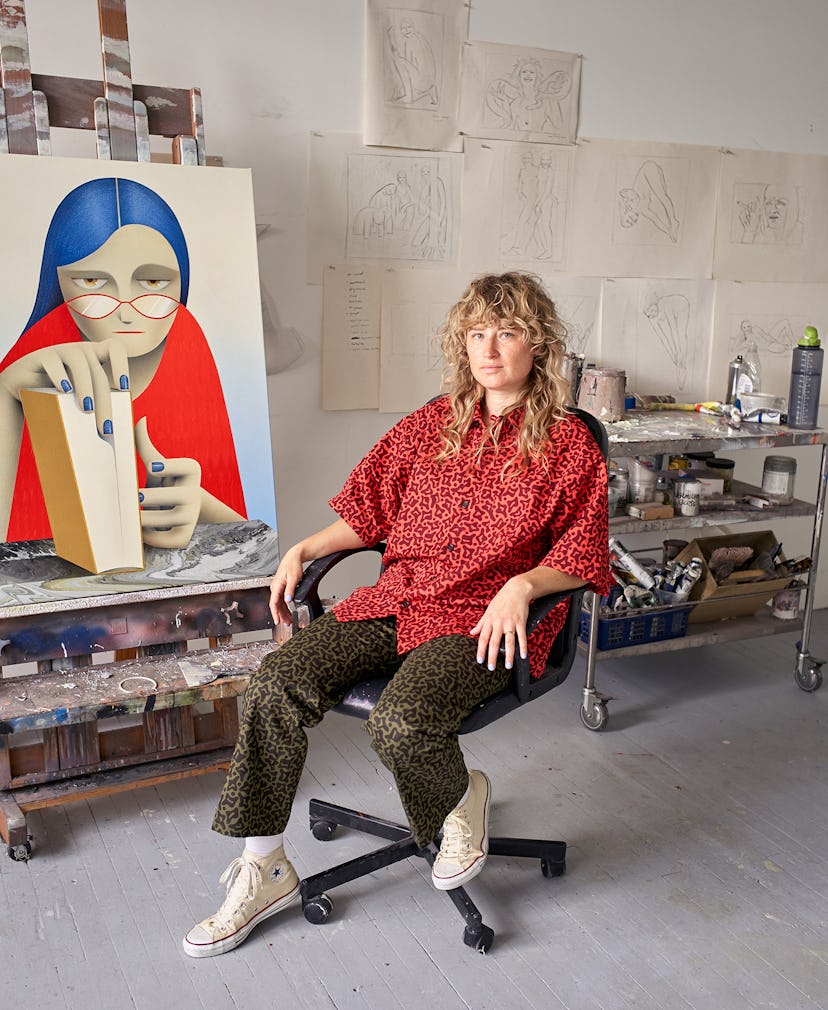Brooklyn-Based Artist Robin F. Williams Paints Women Who Command Your Attention
“Some of these women are saying with their bodies and their expressions, ‘Oh, I’ve been waiting for you,'” Williams says.

The long tradition of figurative painting has had its ups and downs and its dead ends, but it has proved remarkably resilient in the long run: Artists as diverse as Dana Schutz, Elizabeth Peyton, and John Currin have found ways to make it fresh and exciting. The latest painter to stop viewers in their tracks with pictures of people is the Brooklyn-based Robin F. Williams, who recently showed a suite of new works, “With Pleasure,” at the Los Angeles gallery Various Small Fires. With a grasp of bold color and scale, she has especially excelled at painting monumental women who hold the picture plane commandingly, but who bring some humor to the party too. “I love giving the women in the paintings the agency to tell the viewers to fuck off,” says Williams, 35, with a laugh.
The characters at the center of the compositions sometimes look annoyed, as in Alexa Plays Ball, in which a woman clutches a football while she in turn is clutched and held aloft by a man; both are naked. In Ice Queen, a nude woman on her back, legs in the air, has a massive smile plastered on her face. Is she grinning and bearing it? Or laughing at our looking at her? Williams is aware of the tension in those possible readings. “There are psychologically complex things happening,” she says.
*Weathervane*, 2018.
Williams grew up outside of Columbus, Ohio, and started painting at an early age. “My grandmother took me to some art lessons when I was 5,” she recalls. “A woman was offering them in the basement of a community center. I saw her every week for three hours on Wednesday nights, until high school.” She then attended the Rhode Island School of Design, where she started out studying illustration. “I thought I would have a very practical job as an illustrator, which I later learned no longer existed,” she says. That training, however, came in handy as she transitioned to painting, giving her work graphic oomph and a sense of balance.
Not that the mid-aughts, when she graduated, were a great time for the kind of work that she does. “I’ve been painting figuratively since 2006, and I was aware that that mode wasn’t considered seriously then,” she says. “But I think I’ve always really tried to paint what I wanted to see, and just shut out the other noise.”
Williams initially depicted children and adolescents, then moved into a body of work about men that was focused on the idea of American masculinity. Those pictures—full of odd details and intense color palettes—were “the furthest toward realism, and with the least humor,” she says now. Sometimes her men appeared as secondary elements in off-center still lifes, making them about as important as a plant or a vase. In the current pieces, men are part of the story, but the eye is drawn to the women. Her version of a Picassoesque bathers scene depicts a beach setting with two nude women holding a naked man upside down by his legs. He looks tickled to be there; they look like they are holding the weight of the world. Like many of her current works, it’s funny, and then it’s not.
*Siri Calls for Help*, 2018.
To those art-world denizens who like to dabble in a theoretical approach, Williams is providing catnip in the way she has exploded and rethought ideas about the gaze—that objectifying view of women by men, or of a subject by a viewer. “I like flipping the assumption of who came upon whom first,” Williams says. “Some of these women are saying with their bodies and their expressions, ‘Oh, I’ve been waiting for you.’ The implication is that the viewer was their idea, instead of the other way around.”
It’s that kind of big-picture thinking that has led Williams to success with collectors. She paints only some 12 to 15 canvases a year, and is starting to work with Pace Prints to produce works on paper too. She is keenly aware that her success relies on not simplifying or smoothing over contradictions and conflict when it comes to sex and gender, pictorially and otherwise. “There’s something that can’t quite be reconciled” in her paintings, she says. “And that is continually exciting for me.”